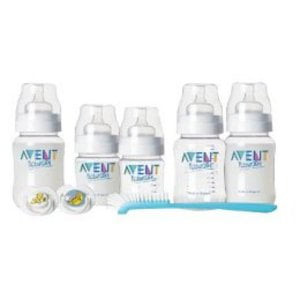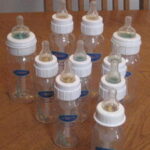New parents and parents to be have a lot of purchases to make. From car seats, clothes, and cribs, they are always being bombarded with new things to buy. One of the most important decisions is actually one of the cheapest. The right bottle can make all the difference. Nursed babies will plainly reject bottles that they do not like. Both nursed and exclusively formula feed babies will prefer certain nipples and eat better from some than others. Certain bottles also claim to help reduce gas.
Both my children have been breastfeed with supplemental formula and expressed milk bottles. So I have had to find bottles that worked well with both nursed children and children prone to gassiness. The two bottles that worked best for my family were Avent bottles and Dr. Brown’s bottles. The most important characteristics for us were bottles that our children would accept, price, amount it leaks, easiness to clean, and ability to reduce gassiness.
Being nursed my children would not accept just any bottle. Both immediately took to the Avent bottle. Avent’s website boast that they support Breastfeeding. It states that “Naturally shaped teat promotes proper latch-on and makes it easier to combine breast and bottle. ” This claim is also supported by other users found though positive feedback on multiple websites. The downside to these bottles was they have a very slow rate of flow. Dr. Brown’s was not as quickly accepted by my two. Its nipple is not formed to closely resemble a nipple. Once they learned how to drink from Dr. Brown’s, they began to like it because the rate of flow was quicker, so they got more food easily. Both these bottles run on the high side. Target.com carries 3 4 oz Dr. Brown bottles for 12.49 and 3 4 oz Avent bottles. So there is little difference in price.
Both of Avent and Dr. Brown bottles have reputations for being leaky bottles. When I first began using the bottles I would experience issues with leaky bottles. Once I got the directions out, these accidents were reduced. I still had a few problems with the Avent bottles leaking but that was because the assembly of the Avent bottle does require a little attention which can be difficult with a hungry baby in your arms.
A busy mom does not have time to spare. Cleaning bottles can be a time consuming chore, but with babies delicate immune system it is vital that be done correctly. Avent bottles are very easy to clean and can be cleaned effectively simply by taking apart and putting in the dishwasher. Dr. Brown bottles are more complicated. You can throw all the pieces in dishwasher but since it has a special internal valve I always felt the need to hand wash them. The special patented internal vent system requires special attention with a small brush to clean correctly. Also when you put them though the dishwasher the sticker on the outside of the bottle starts wearing off.
Both bottles did a good job on helping reduce the gassiness that results from babies taking too much air as they eat. The Avent bottles have actually been clinically proven to help reduce colic. I did notice that my children still experienced spit-up problems with the Avent bottles, but not with Dr. Brown’s bottles. Dr. Brown’s bottles websites claims that the “unique internal vent eliminates the vacuum and air bubbles, to help reduce colic, spit-up, burping and gas.”
With my daughter, I have lean more towards the Avent bottles. Although Dr. Brown’s bottles help reduce spit-up and are slightly easier to use, I prefer Avent because its shape better simulates the breast. I also feel that they are much easier to clean, helping protect her immune system.



